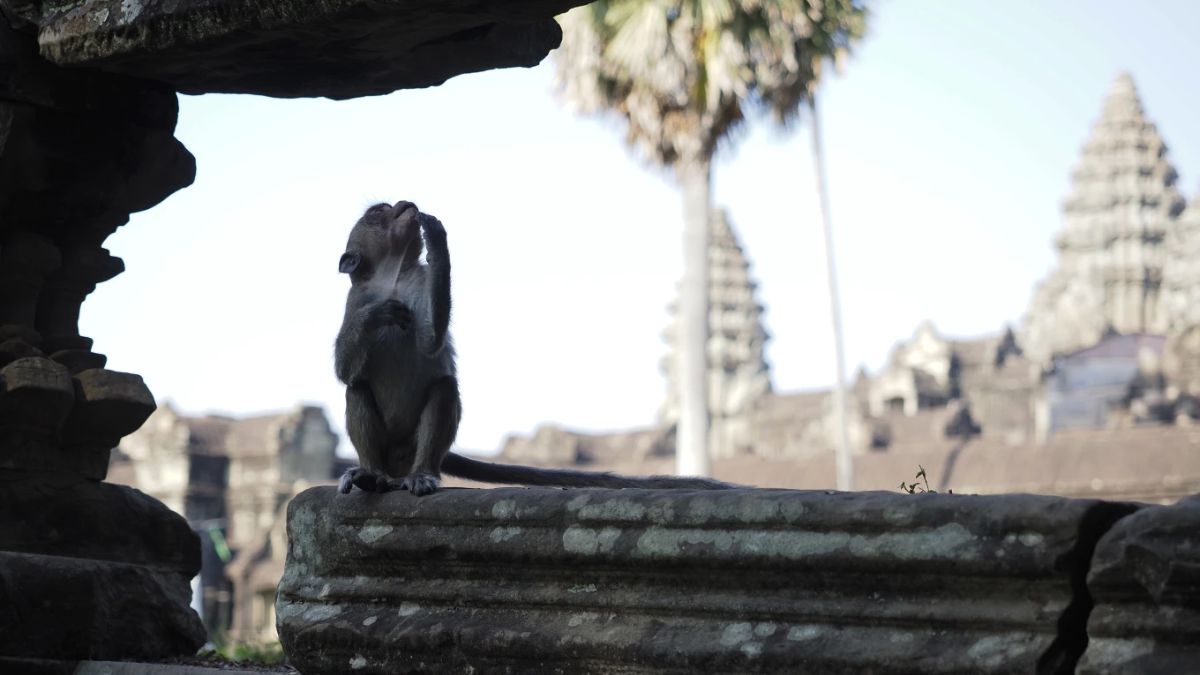Angkor Wat, one of the world’s most breathtaking historical sites in Cambodia, is facing an unexpected threat—not from time or neglect, but from social media influencers.
In a bid to create viral content, some YouTubers have been feeding and provoking the temple’s resident monkeys, turning them into aggressive nuisances that now attack tourists, damage ancient structures, and disrupt the sacred atmosphere of the UNESCO-listed site.
Authorities are now scrambling for a solution and are urging visitors to steer clear of the growing gangs of angry macaques that live around the sprawling complex of ruins. What’s happening? Here’s a closer look at the situation.
The monkey menace
For years, the macaques of Angkor Wat were just another part of the temple’s charm. Visitors would snap pictures as the monkeys climbed trees, played on temple ruins, and occasionally wiped a snack from a visitor.
With the temple becoming Cambodia’s top tourist attraction, these interactions only grew. According to AFP, more than a million foreign visitors explored the site last year, and taking cute videos with the monkeys has become a common activity.
However, in recent years, YouTubers looking for viral content have taken things too far. Many have been luring the monkeys with food—particularly bananas—to get dramatic close-ups and in some cases abuse them physically.
YouTuber Ium Daro, who films Angkor monkeys regularly, told AP that he hadn’t seen any monkeys abused, and that he didn’t see a problem with what he and the others were doing to make a living.
“The monkeys here are friendly,” he said. “After we take their pictures we give them food, so it is like we pay them for them giving us the chance to take their picture.”
However, the Apsara National Authority warns that this human interaction has gradually reshaped the monkeys’ natural instincts. Instead of behaving like wild animals, they now act more like aggressive pets, snatching food and even injuring people.
“There are no exact figures, but some individuals have sustained injuries, including torn skin, while others have had their food stolen,” Long Kosal, a spokesman for the Apsara National Authority told The Post.
Tourist Cadi Hutchings, who visited the UNESCO site some time back, was well aware of the risk. After a warning from her tour guide, she made sure to keep her distance.
“What they want is your food, but you also need to appreciate that there needs to be a boundary between human intervention in nature,” the 23-year-old from Wales told AP. “It’s obviously a great thing that so many tourists come because it’s such a lovely place, but at the same time, you have to be careful that with more and more people…the monkeys don’t get too acclimatised.”
A threat to the 900-year-old temple
It’s not just tourists who are at risk—the growing chaos caused by macaques is also endangering Angkor Wat itself.
Kosal told AFP that alongside the safety concerns for visitors, officials are increasingly alarmed about the damage these monkeys are causing to the centuries-old temple.
“On top of biting visitors, they have been climbing up and pushing stones down, damaging temples,” he said, adding that the macaques have also destroyed information boards.
What are authorities doing?
The Cambodian authorities have urged tourists to avoid engaging with the monkeys while exploring the ruins and are now searching for “an appropriate solution” to address the problem before more harm is done.
There’s even talk of relocating some of the more aggressive ones, but that’s easier said than done. The Ministry of Agriculture has announced plans for a monkey census to better understand the population and find a long-term solution.
Since earning UNESCO World Heritage status in 1992, Angkor Wat and its surrounding jungle have been granted increased legal and physical protections.
Officials hope that responsible wildlife sightings will not only attract more visitors but also encourage conservation awareness among both locals and tourists.
However, balancing tourism, heritage preservation, and wildlife protection remains a complex challenge.
With input from agencies
)